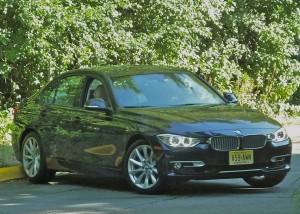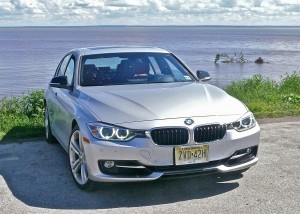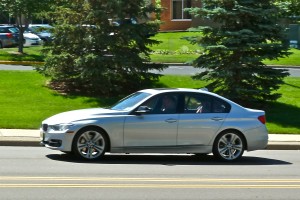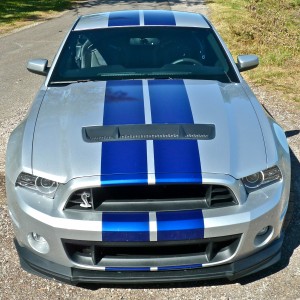Which BMW 3 is better? Flip a coin.
By John Gilbert
The BMW 3-Series has risen to a position above and beyond the prestige of a normal icon. The “3” design tips off everyone that the car inside will perform and handle with something approaching flawless precision. The car’s reputation is such that all other manufacturers tend to introduce cars by claiming that they used the BMW 3-Series as their benchmark for handling.
BMW introduced the 3-Series with a press drive that included hot laps around Mazda Laguna Seca road-racing track, and further drives along the Pacific Coast Highway south of Monterey to Big Sur — one of the most scenic highways in the world.
Even then, however, I couldn’t wait for the chance to test-drive a 3-Series on Lake Superior’s North Shore, which happens to be my favorite scenic highway, and besides, it’s closer to home. The car comes with optional all-wheel drive, but in the midst of the hottest July on record in Minnesota, the traditional rear-drive was more than just fine.
At that, I was not fully prepared for what was to come when I got to spend a week driving the 6-cylinder BMW 335i. Two weeks later, I also got the chance for a week driving the 4-cylinder BMW 328i.

Less-expensive (slightly) and less potent (also slightly) 328i shares body and features with the 335i.
From the introductory tests, it seemed to me that the turbocharged 4 had sufficient power to eliminate any need for the more powerful BMW 335i, and it must be more economical too, right?
Not long after that, the pair of BMW 3s turned my assumptions upside down, and back again.
First, we had the 335i, with the priceless BMW inline 6-cylinder engine, measuring 3.0 liters of displacement, with dual-overhead camshafts operating the 24 valves.
While “just” a 4-door sedan, the 335i has something of a menacing look, and the drivetrain remains its inner jewel. One of the world’s truly fine engines, the 3.0 has TwinPower turbo technology, high-pressure precision direct injection, Valvetronic valvetrain, and Double VANOS t variable valve timing on both intake and exhaust valves. The 3-Series can be had with any flavor of 3.0-liter engines. The test car is twin-turbocharged, boosting power up to 300 horsepower and 300 foot-pounds of torque, allowing it to zip around with power and class.
The sticker shock reads $42,400 for base price, with options pushing the final tag to $55,870. That’s a lot, but it seems more reasonable after you spend some time appreciating the basic car plus the added features.
Driving on metropolitan highways and streets, the 335i exudes a certain class that approaches hotter sports cars and is far above normally recognized sporty sedans. Handling is flawless, which is no surprise, and while the car is smaller than most midsizers and more like a compact, although rear seat room is certainly adequate.
Performance is smooth and precise, harnessed by the Sport Line’s adaptive suspension off the M3 design, and with the Sport automatic transmission, which has eight speeds. Drivers can control things with paddles mounted within thumb’s reach on the steering wheel. I only really pushed the car once, and that was coming easterly on I-610 north of Minneapolis, where taking the Duluth exit north requires a left exit, which winds onto an overpass before curving gradually to the right, then more sharply, before finally hooking in a decreasing-radius arc. It is not what traffic engineers could possibly have thought would be the safest alternative for normal cars, but it is squeezed into a tight bit of real estate and is pure pleasure in a great-handling car.
Knowing the curve well, and having the pleasure of nobody around me, fore or aft, I went into the last part of the turn where the sign advises 25 mpg; I had downshifted a couple times, but was still going more like 47 mph. The car was so planted that I accelerated hard the rest of the way around, and we sailed onto Interstate 35 smoothly. It was close to breathtaking.
You can cheat with that engine, using console controls to push a button to engage “sport,” or clicking another one to get “sport plus.” I would recommend sport plus only on perfectly smooth surfaces, or at a race track. But sport works just fine as a compromise to quicken and raise shift points and tighten the suspension. Read more
Shelby GT500 sets iconic standards for 2013
By John Gilbert
A lot of people give nicknames to their favorite cars. “Old Betsy” has given way to a lot of catchier, more contemporary and more personalized monickers. This one could be “Silver Bullet,” or maybe “Blue Streak.” It also could be called outrageous, because in this fuel-economy-conscious era its primary objective is to be mind-boggling fast, every time you touch the throttle, in any of six manually selected gears.
The car in question is the 2013 Shelby GT500, a rocket on wheels that is earthbound, if just barely. The Shelby GT 500 I “owned” for a week-long coexistence was “ingot silver metallic,” with a wide, perfectly contrasting blue stripe running down from its roof, hood and front and rear ends.
Ford claims to have topped 200 miles per hour in in Europe during finishing test runs for this 665 horsepower mind-blower. Others have written that the car won’t go a tick over 198. No sane person, of course, would attempt that unless on a race track, or on a German autobahn in those regions where speed limits are still unlimited. The thrill, for those willing to lay down $60,000 for the ultimate ponycar, is to have the capability, just the potential, to display enormous power every time you turn the key and let out the firm but not-unworkable clutch pedal.
The newest generation of Shelby GT is the latest in a succession of hot-rod Mustangs that were first built by Carroll Shelby, and then recreated to Shelby’s demanding standards back in the late 1960s. To me, the most stunning of them all was the 1969 Shelby GT, which stayed almost the same for 1970, then veered off into other iterations. I admit I’m prejudiced, though, because I owned a 1970 Boss 302 Mustang, and after it got rear-ended and nearly destroyed by a drowsy truck-driver at a rural construction stop, I found a badly treated used Shelby and bought it, then had the sleek body fitted onto the platform and drivetrain of my Boss 302.
The car has moved on, but the name Shelby always retained its magic. I thought that Ford had undercut Carroll Shelby when it developed the Boss 302, and Shelby moved on to other things, working for a new Oldsmobile venture for a while, and employed by Dodge when it built and introduced the Viper. I had met Carroll Shelby when he ran a Trans-Am race team of Mustangs, and I had a wonderful chance to have lunch with him in Dallas, at the Viper introduction. I got Shelby to autograph the white-on-white cap they issued, and I still have it.
Ford lured the aging and infirm Shelby back into the company a few years ago, which was fitting. It was more fitting that the last time I saw Carroll Shelby was only a short time before he died. It was back in November of 2011 in Los Angeles, where this newest generation of Shelby GT500 Mustang was introduced, on the eve of the first media day at the Los Angeles Auto Show.
As befitting Shelby’s style of iconoclastic rebel, that press party was a coup. The assembled media was dazzled that Ford, which had just turned out a cluster of small cars that ran clean and could attain 40 miles per gallon, would unveil a 2013 Shelby GT500 with 662 horsepower and 631 foot-pounds of torque from a revised and supercharged 5.8-liter, dual-overhead-camshaft V8. The coup came the next morning, when Chevrolet had secured an early-morning press gala at the show to introduce its new ZL-1 Camaro. Chevrolet officials understandably gushed about its enormous tally of 580 horsepower and 556 foot-pounds of torque from a supercharged 6.2-liter Corvette V8 — because they didn’t know the car had been upstaged by 82 horsepower and 75 foot-pounds of torque at Ford’s party the night before. Read more






 John Gilbert is a lifetime Minnesotan and career journalist, specializing in cars and sports during and since spending 30 years at the Minneapolis Tribune, now the Star Tribune. More recently, he has continued translating the high-tech world of autos and sharing his passionate insights as a freelance writer/photographer/broadcaster. A member of the prestigious North American Car and Truck of the Year jury since 1993. John can be heard Monday-Friday from 9-11am on 610 KDAL(www.kdal610.com) on the "John Gilbert Show," and writes a column in the Duluth Reader.
John Gilbert is a lifetime Minnesotan and career journalist, specializing in cars and sports during and since spending 30 years at the Minneapolis Tribune, now the Star Tribune. More recently, he has continued translating the high-tech world of autos and sharing his passionate insights as a freelance writer/photographer/broadcaster. A member of the prestigious North American Car and Truck of the Year jury since 1993. John can be heard Monday-Friday from 9-11am on 610 KDAL(www.kdal610.com) on the "John Gilbert Show," and writes a column in the Duluth Reader.